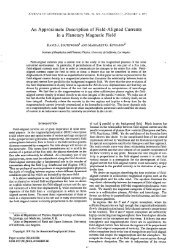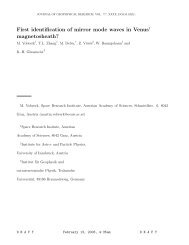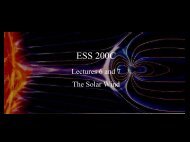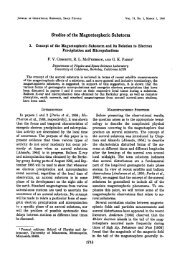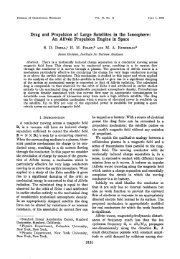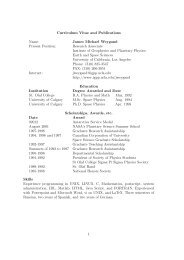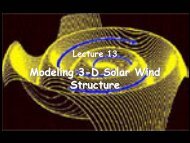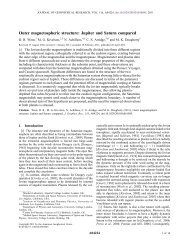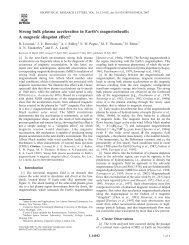A Brief Introduction to Space Plasma Physics.pdf - Institute of ...
A Brief Introduction to Space Plasma Physics.pdf - Institute of ...
A Brief Introduction to Space Plasma Physics.pdf - Institute of ...
Create successful ePaper yourself
Turn your PDF publications into a flip-book with our unique Google optimized e-Paper software.
ESS 200C - <strong>Space</strong> <strong>Plasma</strong> <strong>Physics</strong><br />
Winter Quarter 2006-2007<br />
Date Topic<br />
1/8 Organization and <strong>Introduction</strong><br />
<strong>to</strong> <strong>Space</strong> <strong>Physics</strong> I<br />
1/10 <strong>Introduction</strong> <strong>to</strong> <strong>Space</strong> <strong>Physics</strong> II<br />
1/17 <strong>Introduction</strong> <strong>to</strong> <strong>Space</strong> <strong>Physics</strong> III<br />
1/19 The Sun I<br />
1/22 The Sun II<br />
1/24 The Solar Wind I<br />
1/29 The Solar Wind II<br />
1/31 First Exam<br />
2/5 Bow Shock and Magne<strong>to</strong>sheath<br />
2/7 The Magne<strong>to</strong>sphere I<br />
Raymond J. Walker<br />
Schedule <strong>of</strong> Classes<br />
Date Topic<br />
2/14 The Magne<strong>to</strong>sphere II<br />
2/16 The Magne<strong>to</strong>sphere III<br />
2/21 Planetary Magne<strong>to</strong>spheres<br />
2/23 The Earth’s Ionosphere<br />
2/26 Subs<strong>to</strong>rms<br />
3/5 Aurorae<br />
3/7 Planetary Ionospheres<br />
3/12 Pulsations<br />
3./14 S<strong>to</strong>rms and Review<br />
Second Exam
ESS 200C – <strong>Space</strong> <strong>Plasma</strong><br />
<strong>Physics</strong><br />
• There will be two examinations and homework assignments.<br />
• The grade will be based on<br />
– 35% Exam 1<br />
– 35% Exam 2<br />
– 30% Homework<br />
• References<br />
– Kivelson M. G. and C. T. Russell, <strong>Introduction</strong> <strong>to</strong> <strong>Space</strong><br />
<strong>Physics</strong>, Cambridge University Press, 1995.<br />
– Gombosi, T. I., <strong>Physics</strong> <strong>of</strong> the <strong>Space</strong> Environment, Cambridge<br />
University Press, 1998<br />
– Kellenrode, M-B, <strong>Space</strong> <strong>Physics</strong>, An <strong>Introduction</strong> <strong>to</strong> <strong>Plasma</strong>s and<br />
Particles in the Heliosphere and Magne<strong>to</strong>spheres, Springer, 2000.<br />
– Walker, A. D. M., Magne<strong>to</strong>hydrodynamic Waves in <strong>Space</strong>, <strong>Institute</strong><br />
<strong>of</strong> <strong>Physics</strong> Publishing, 2005.
<strong>Space</strong> <strong>Plasma</strong> <strong>Physics</strong><br />
• <strong>Space</strong> physics is concerned with the interaction <strong>of</strong><br />
charged particles with electric and magnetic fields in<br />
space.<br />
• <strong>Space</strong> physics involves the interaction between the<br />
Sun, the solar wind, the magne<strong>to</strong>sphere and the<br />
ionosphere.<br />
• <strong>Space</strong> physics started with observations <strong>of</strong> the<br />
aurorae.<br />
– Old Testament references <strong>to</strong> auroras.<br />
– Greek literature speaks <strong>of</strong> “moving accumulations<br />
<strong>of</strong> burning clouds”<br />
– Chinese literature has references <strong>to</strong> auroras prior<br />
<strong>to</strong> 2000BC
• Aurora over Los Angeles (courtesy V.<br />
Peroomian)
– Galileo theorized that aurora is caused by air rising out <strong>of</strong><br />
the Earth’s shadow <strong>to</strong> where it could be illuminated by<br />
sunlight. (Note he also coined the name aurora borealis<br />
meaning “northern dawn”.)<br />
– Descartes thought they are reflections from ice crystals.<br />
– Halley suggested that auroral phenomena are ordered by<br />
the Earth’s magnetic field.<br />
– In 1731 the French philosopher de Mairan suggested they<br />
are connected <strong>to</strong> the solar atmosphere.
• By the 11th century the<br />
Chinese had learned that<br />
a magnetic needle points<br />
north-south.<br />
• By the 12th century the<br />
European records<br />
mention the compass.<br />
• That there was a<br />
difference between<br />
magnetic north and the<br />
direction <strong>of</strong> the compass<br />
needle (declination) was<br />
known by the 16th<br />
century.<br />
• William Gilbert (1600)<br />
realized that the field was<br />
dipolar.<br />
• In 1698 Edmund Halley<br />
organized the first<br />
scientific expedition <strong>to</strong><br />
map the field in the<br />
Atlantic Ocean.
The <strong>Plasma</strong> State<br />
• A plasma is an electrically neutral ionized<br />
gas.<br />
– The Sun is a plasma<br />
– The space between the Sun and the Earth<br />
is “filled” with a plasma.<br />
– The Earth is surrounded by a plasma.<br />
– A stroke <strong>of</strong> lightning forms a plasma<br />
– Over 99% <strong>of</strong> the Universe is a plasma.<br />
• Although neutral a plasma is composed <strong>of</strong><br />
charged particles- electric and magnetic<br />
forces are critical for understanding plasmas.
The Motion <strong>of</strong> Charged Particles<br />
• Equation <strong>of</strong> motion<br />
m<br />
r<br />
dv<br />
dt<br />
r<br />
= qE<br />
r r<br />
+ qv × B +<br />
• SI Units<br />
– mass (m) - kg<br />
– length (l) - m<br />
– time (t) - s<br />
– electric field (E) - V/m<br />
– magnetic field (B) - T<br />
– velocity (v) - m/s<br />
– F g stands for non-electromagnetic forces (e.g. gravity) -<br />
usually ignorable.<br />
r<br />
F g
• B acts <strong>to</strong> change the motion <strong>of</strong> a charged particle<br />
only in directions perpendicular <strong>to</strong> the motion.<br />
– Set E = 0, assume B along z-direction.<br />
mv&<br />
mv&<br />
v&&<br />
x<br />
v&&<br />
y<br />
x<br />
y<br />
=<br />
qv<br />
y<br />
= −qv<br />
2<br />
qv&<br />
yB<br />
q vxB<br />
= = −<br />
2<br />
m m<br />
2 2<br />
q vyB<br />
= −<br />
2<br />
m<br />
– Equations <strong>of</strong> circular motion with angular frequency<br />
(cyclotron frequency or gyro frequency<br />
Ω = qB<br />
c<br />
m<br />
– If q is positive particle gyrates in left handed sense<br />
– If q is negative particle gyrates in a right handed sense<br />
B<br />
x<br />
B<br />
2
• Radius <strong>of</strong> circle ( r c ) - cyclotron radius or Larmor<br />
radius or gyro radius. v = ρ Ω<br />
mv<br />
qB<br />
– The gyro radius is a function <strong>of</strong> energy.<br />
– Energy <strong>of</strong> charged particles is usually given in electron volts<br />
(eV)<br />
– Energy that a particle with the charge <strong>of</strong> an electron gets in<br />
falling through a potential drop <strong>of</strong> 1 Volt- 1 eV = 1.6X10 -19<br />
Joules (J).<br />
• Energies in space plasmas go from electron Volts <strong>to</strong><br />
kiloelectron Volts (1 keV = 10 3 eV) <strong>to</strong> millions <strong>of</strong> electron Volts<br />
(1 meV = 10 6 eV)<br />
• Cosmic ray energies go <strong>to</strong> gigaelectron Volts ( 1 geV = 10 9 eV).<br />
• The circular motion does no work on a particle<br />
r r<br />
F ⋅v<br />
=<br />
r<br />
dv<br />
m<br />
dt<br />
r<br />
⋅v<br />
⊥<br />
ρ<br />
c<br />
=<br />
c<br />
1<br />
d(<br />
2<br />
mv<br />
=<br />
dt<br />
2<br />
⊥<br />
)<br />
c<br />
r r r<br />
= qv ⋅(<br />
v × B)<br />
= 0<br />
Only the electric field can energize particles!
• The electric field can modify the particles motion.<br />
– Assume E r ≠ 0 but B r still uniform and F g =0.<br />
– Frequently in space physics it is ok <strong>to</strong> set E<br />
r<br />
⋅ B r<br />
= 0<br />
• Only E r<br />
can accelerate particles along B r<br />
• Positive particles go along E and negative particles go<br />
along − E<br />
• Eventually charge separation wipes out E<br />
E ⊥<br />
– has a major effect on motion.<br />
• As a particle gyrates it moves along E r and gains energy<br />
• Later in the circle it losses energy.<br />
• This causes different parts <strong>of</strong> the “circle” <strong>to</strong> have different radii -<br />
it doesn’t close on itself.<br />
r r<br />
r E × B<br />
=<br />
u E<br />
2<br />
B<br />
• Drift velocity is perpendicular <strong>to</strong> and<br />
• No charge dependence, therefore no currents<br />
E r<br />
B r
• Any force capable <strong>of</strong> accelerating and decelerating<br />
charged particles can cause<br />
r r<br />
them <strong>to</strong> drift.<br />
r F × B<br />
u F<br />
=<br />
2<br />
qB<br />
– If the force is charge independent the drift motion will<br />
depend on the sign <strong>of</strong> the charge and can form<br />
perpendicular currents.<br />
• Changing magnetic fields cause a drift velocity.<br />
– If B r changes over a gyro-orbit the radius <strong>of</strong> curvature will<br />
change.<br />
mv⊥<br />
– ρc<br />
= gets smaller when the particle goes in<strong>to</strong> a region <strong>of</strong><br />
qB<br />
stronger B. Thus the drift is opposite <strong>to</strong> that <strong>of</strong> E<br />
r B<br />
r<br />
r r × motion.<br />
r<br />
−1<br />
2 ∇B<br />
× B<br />
1 2 B × ∇B<br />
u g<br />
=<br />
2<br />
mv⊥<br />
=<br />
3 2<br />
mv⊥<br />
3<br />
qB<br />
qB<br />
– u g depends on the charge so it can yield perpendicular<br />
currents.
• The change in the direction <strong>of</strong> the magnetic field<br />
along a field line can cause motion.<br />
– The curvature <strong>of</strong> the magnetic field line introduces a drift<br />
motion.<br />
• As particles move along the field they undergo centrifugal<br />
acceleration.<br />
2<br />
r<br />
F<br />
mv<br />
R<br />
nˆ<br />
• R c<br />
is the radius <strong>of</strong> curvature <strong>of</strong> a field line ( = −(<br />
bˆ<br />
⋅∇)<br />
bˆ<br />
)<br />
where<br />
Rc<br />
r<br />
B<br />
bˆ = , nˆ is perpendicular <strong>to</strong> B r<br />
and points away from the center<br />
B<br />
<strong>of</strong> curvature, v is the component <strong>of</strong> velocity along B r<br />
r<br />
u<br />
c<br />
=<br />
mv<br />
• Curvature drift can cause currents.<br />
=<br />
c<br />
Rˆ<br />
c<br />
r<br />
B×<br />
( bˆ<br />
⋅∇)<br />
bˆ<br />
2 2<br />
ˆ<br />
qB<br />
2<br />
r<br />
mv B×<br />
n<br />
= −<br />
2<br />
R qB<br />
c
• The Concept <strong>of</strong> the Guiding Center<br />
v r<br />
– Separates the motion ( ) <strong>of</strong> a particle in<strong>to</strong> motion<br />
perpendicular ( ) and parallel ( v ) <strong>to</strong> the magnetic field.<br />
v<br />
⊥<br />
– To a good approximation the perpendicular motion can<br />
consist <strong>of</strong> a drift ( ) and the gyro-motion ( )<br />
r<br />
v<br />
=<br />
r<br />
v<br />
v D<br />
– Over long times the gyro-motion is averaged out and the<br />
particle motion can be described by the guiding center<br />
motion consisting <strong>of</strong> the parallel motion and drift. This is very<br />
useful for distances l such that ρ c<br />
l
• Maxwell’s equations<br />
– Poisson’s Equation<br />
∇ ⋅ E r<br />
=<br />
ρ<br />
ε 0<br />
• E r is the electric field<br />
• ρ is the charge density<br />
• ε is the electric permittivity (8.85 X 10 -12 0<br />
Farad/m)<br />
– Gauss’ Law (absence <strong>of</strong> magnetic monopoles)<br />
∇ ⋅ B r<br />
= 0<br />
• is the magnetic field<br />
B r
– Faraday’s Law<br />
– Ampere’s Law<br />
r<br />
∇× B =<br />
• c is the speed <strong>of</strong> light.<br />
• Is the permeability <strong>of</strong> free space, H/m<br />
0<br />
• is the current density<br />
r<br />
r ∂B<br />
∇× E = −<br />
∂t<br />
1<br />
c<br />
2<br />
r<br />
∂E<br />
∂t<br />
r<br />
+ µ J<br />
−7<br />
µ µ = 4π ×<br />
J r<br />
0<br />
0<br />
10
• Maxwell’s equations in integral form<br />
r 1<br />
∫ E ⋅ ndA ˆ = ∫ ρ dV<br />
A<br />
ε 0<br />
– A is the area, dA is the differential element <strong>of</strong> area<br />
– nˆ is a unit normal vec<strong>to</strong>r <strong>to</strong> dA pointing outward.<br />
– V is the volume, dV is the differential volume element<br />
ˆn '<br />
∫<br />
∫<br />
A<br />
C<br />
r<br />
B ⋅ nd ˆ A =<br />
v r<br />
E ⋅ ds = −<br />
0<br />
r<br />
∂B<br />
∂t<br />
'<br />
⋅nˆ<br />
dF = −<br />
∂Φ<br />
∂ t<br />
– is a unit normal vec<strong>to</strong>r <strong>to</strong> the surface element dF in the<br />
direction given by the right hand rule for integration around<br />
C, and is magnetic flux through the surface.<br />
ds<br />
r<br />
Φ<br />
– is the differential element<br />
r<br />
around C.<br />
r r ∂E<br />
'<br />
∫ B ⋅ds<br />
= 2 n dF J<br />
C<br />
c ∫ ⋅ ˆ + µ<br />
0<br />
∂t<br />
∫<br />
∫<br />
1<br />
ˆ<br />
'<br />
⋅n dF
• The first adiabatic invariant<br />
r<br />
∂B<br />
r<br />
– = −∇× E says that changing B r<br />
drives E r<br />
(electromotive<br />
∂t<br />
force). This means that the particles change energy in<br />
changing magnetic fields.<br />
– Even if the energy changes there is a quantity that remains<br />
constant provided the magnetic field changes slowly enough.<br />
– µ is called the magnetic moment. In a wire loop the<br />
magnetic moment is the current through the loop times the<br />
area.<br />
µ<br />
1 2<br />
2<br />
mv =<br />
⊥ =<br />
B<br />
– As a particle moves <strong>to</strong> a region <strong>of</strong> stronger (weaker) B it is<br />
accelerated (decelerated).<br />
const.
• For a coordinate in which the motion is<br />
periodic the action integral<br />
J<br />
i<br />
= ∫ pidqi<br />
= constant<br />
is conserved.<br />
rHere pr<br />
i is the rcanonical<br />
momentum ( p = mv + qA where A is the<br />
vec<strong>to</strong>r potential).<br />
r r 2πm<br />
• For a gyrating particle J1 = ∫ p⊥<br />
⋅ds<br />
= µ<br />
q<br />
• The action integrals are conserved when the<br />
properties <strong>of</strong> the system change slowly<br />
compared <strong>to</strong> the period <strong>of</strong> the coordinate.
• The magnetic mirror<br />
– As a particle gyrates the current will be<br />
I =<br />
q<br />
T c<br />
where<br />
T c<br />
= π<br />
Ω<br />
c<br />
– The force on a dipole magnetic moment is<br />
where<br />
A = π r<br />
IA<br />
=<br />
π v<br />
2<br />
c<br />
2<br />
⊥<br />
2π<br />
Ω<br />
v<br />
= π<br />
Ω<br />
q Ω<br />
c<br />
2<br />
c<br />
=<br />
2<br />
⊥<br />
2<br />
c<br />
mv<br />
2B<br />
r<br />
dB<br />
F = −<br />
r µ ⋅∇B<br />
= −µ<br />
r<br />
dz<br />
µ = µ bˆ<br />
2<br />
⊥<br />
=<br />
2 µ
B r<br />
• The force is along and away from the direction <strong>of</strong><br />
increasing B.<br />
• Since E = 0 and kinetic energy must be conserved<br />
1 2 1 2 2<br />
2<br />
mv =<br />
2<br />
m(<br />
v + v⊥)<br />
a decrease in v must yield an increase in v⊥<br />
• Particles will turn around when<br />
B =<br />
1<br />
mv<br />
2<br />
2<br />
µ
• The second adiabatic invariant<br />
– The integral <strong>of</strong> the parallel momentum over one<br />
complete bounce between mirrors is constant (as<br />
long as B doesn’t change much in a bounce).<br />
J<br />
= ∫<br />
s<br />
s<br />
1<br />
2<br />
2mv<br />
ds<br />
= const.<br />
– Using conservation <strong>of</strong> energy and the first<br />
adiabatic invariant<br />
J<br />
= ∫<br />
s<br />
s<br />
1<br />
2<br />
B<br />
2<br />
2mv(1<br />
− )<br />
1<br />
ds<br />
B<br />
here B m is the magnetic field at the mirror point.<br />
m<br />
= const.
– As particles bounce they will drift<br />
because <strong>of</strong> gradient and<br />
curvature drift motion.<br />
– If the field is a dipole their<br />
trajec<strong>to</strong>ries will take them around<br />
the planet and close on<br />
themselves.<br />
• The third adiabatic invariant<br />
– As long as the magnetic field<br />
doesn’t change much in the time<br />
required <strong>to</strong> drift around a rplanet<br />
the magnetic flux Φ = ∫ B ⋅ nˆ<br />
dA<br />
inside the orbit must be constant.<br />
– Note it is the <strong>to</strong>tal flux that is<br />
conserved including the flux<br />
within the planet.
• Limitations on the invariants<br />
µ<br />
– is constant when there is little change in the field’s<br />
strength over a cyclotron path.<br />
∇B<br />
B<br />
– All invariants require that the magnetic field not change much in the<br />
time required for one cycle <strong>of</strong> motion<br />
1<br />
B<br />
The Properties <strong>of</strong> a <strong>Plasma</strong><br />
• A plasma as a collection <strong>of</strong> particles<br />
– The properties <strong>of</strong> a collection <strong>of</strong> particles can be described<br />
by specifying how many there are in a 6 dimensional volume<br />
called phase space.<br />
• There are 3 dimensions in “real” or configuration space and 3<br />
dimensions in velocity space.<br />
• The volume in phase space is<br />
dvdr<br />
• The number <strong>of</strong> particles in a phase space volume is<br />
where f is called the distribution function.<br />
– The density <strong>of</strong> particles <strong>of</strong> species “s” (number per unit<br />
volume)<br />
– The average velocity (bulk flow velocity)<br />
r<br />
u<br />
s<br />
r<br />
(<br />
, t)<br />
=<br />
dv<br />
r r r<br />
ns (<br />
, t)<br />
= ∫ fs<br />
(<br />
, v,<br />
t)<br />
dv<br />
x<br />
dv<br />
y<br />
dv<br />
z<br />
dxdydz<br />
r r r r r<br />
= vf (<br />
, v,<br />
t)<br />
dv / f (<br />
, v,<br />
t)<br />
dv<br />
∫<br />
s<br />
∫ s<br />
r r<br />
f (<br />
, v,<br />
t)<br />
dvdr
– Average random energy<br />
r r 2<br />
− = ∫<br />
2 r r r<br />
1<br />
ms ( v us<br />
) ms<br />
( v − us<br />
) fs<br />
(<br />
, v,<br />
t)<br />
dv / fs<br />
(<br />
, v,<br />
t)<br />
dv<br />
r<br />
1<br />
2<br />
2<br />
– The partial pressure <strong>of</strong> s is given by<br />
p<br />
n<br />
s<br />
s<br />
2<br />
N<br />
=<br />
( ) 2 3r −<br />
1 2<br />
(<br />
2ms<br />
( v us<br />
)<br />
where N is the number <strong>of</strong> independent velocity components<br />
(usually 3).<br />
r<br />
∫<br />
– In equilibrium the phase space distribution is a Maxwellian<br />
distribution<br />
r r<br />
⎡ 1<br />
2<br />
r r<br />
( )<br />
( − ) ⎤<br />
2<br />
ms<br />
v us<br />
fs<br />
, v = As<br />
exp⎢<br />
⎥⎦<br />
⎣ kTs<br />
where<br />
A<br />
s<br />
= n<br />
s<br />
m<br />
2π<br />
kT
• For mona<strong>to</strong>mic particles in equilibrium<br />
1 2<br />
2m<br />
( ) NkT<br />
s<br />
v us<br />
= / 2<br />
p<br />
s<br />
=nskTs<br />
where k is the Boltzman constant (k=1.38x10 -23 JK -1 )<br />
• For mona<strong>to</strong>mic particles in equilibrium<br />
m v<br />
r − u<br />
r 2<br />
= NkT<br />
1<br />
2<br />
( ( ) ) 2<br />
• This is true even for magnetized particles.<br />
• The ideal gas law becomes<br />
s<br />
r<br />
− r<br />
s<br />
p = n<br />
s<br />
s<br />
kT<br />
s<br />
s
– Other frequently used distribution functions.<br />
• The bi-Maxwellian distribution<br />
⎡ 1<br />
r r<br />
ms<br />
v − u<br />
'<br />
2<br />
f ( ) = ⎢<br />
s<br />
, v As<br />
exp −<br />
⎢ kT<br />
⎣<br />
s<br />
– where<br />
s s s ⎜ s s ⎟<br />
⎝ ⎠<br />
– It is useful when there is a difference between the distributions<br />
perpendicular and parallel <strong>to</strong> the magnetic field<br />
• The kappa distribution<br />
f<br />
s<br />
r<br />
'<br />
A<br />
r<br />
( r,<br />
v)<br />
=<br />
A<br />
Κ characterizes the departure from Maxwellian form.<br />
– E Ts is an energy.<br />
κs<br />
⎡<br />
⎢1<br />
+<br />
⎣<br />
2<br />
( ) ⎤ r r<br />
⎡ 1<br />
2<br />
( ) ⎤<br />
⎥⎦<br />
1<br />
2<br />
m<br />
s<br />
⎥ exp⎢−<br />
⎥<br />
⎦ ⎣<br />
( v − u )<br />
sκ Ts<br />
s<br />
− u<br />
– At high energies E>>κE Ts it falls <strong>of</strong>f more slowly than a Maxwellian<br />
(similar <strong>to</strong> a power law)<br />
κ → ∞<br />
⎛<br />
⎜T<br />
3<br />
2<br />
= A T<br />
⊥<br />
T<br />
1<br />
2<br />
⎞<br />
⎟<br />
– For it becomes a Maxwellian with temperature kT=E Ts<br />
r<br />
E<br />
r<br />
2<br />
2<br />
⎤<br />
⎥<br />
⎦<br />
m<br />
s<br />
v<br />
−κ<br />
−1<br />
⊥<br />
kT<br />
⊥s<br />
⊥s
• What makes an ionized gas a plasma?<br />
– The electrostatic potential <strong>of</strong> an isolated ion ϕ =<br />
q<br />
4πε 0<br />
r<br />
– The electrons in the gas will be attracted <strong>to</strong> the ion and will reduce<br />
the potential at large distances.<br />
– If we assume neutrality Poisson’s equation around a test charge<br />
q 0<br />
is<br />
∇<br />
– Expanding in a Taylor series for r>0 and for both<br />
–<br />
ϕ<br />
r − ρ q<br />
⎡ ⎛ ⎞ ⎛ ⎞⎤<br />
0 3 en0<br />
eϕ<br />
− eϕ<br />
( ) = = − δ ( r ) + exp⎜<br />
⎟ − exp⎜<br />
⎟⎥ ⎦<br />
2 r<br />
ε<br />
0<br />
electrons and ions<br />
∇<br />
ϕ<br />
r<br />
2<br />
ε<br />
0<br />
en ⎡<br />
⎢<br />
ε<br />
0 ⎣<br />
eϕ<br />
kT<br />
ε<br />
0<br />
⎢<br />
⎣<br />
eϕ<br />
⎤<br />
⎥<br />
kTion<br />
⎦<br />
⎜<br />
⎝ kT<br />
⎟<br />
⎠<br />
eϕ kT<br />
⎜<br />
⎝<br />
e<br />
kT ion<br />
ϕ =<br />
−r<br />
λ<br />
qe D<br />
4π<br />
ε 0<br />
r<br />
•The Debye length ( ) is<br />
where n is the electron number density and now e<br />
is the electron charge.<br />
•The number <strong>of</strong> particles within a Debye sphere<br />
N<br />
D<br />
3<br />
4π<br />
nλ<br />
=<br />
D<br />
3<br />
λ<br />
needs <strong>to</strong> be large for shielding <strong>to</strong> occur<br />
(N D >>1). Far from the central charge the electrostatic<br />
force is shielded.<br />
D<br />
λ D<br />
⎛ 0kT<br />
= ⎜ ne<br />
2<br />
⎝<br />
ε<br />
⎞<br />
⎟<br />
⎠<br />
1<br />
2
• The plasma frequency<br />
– Consider a slab <strong>of</strong> plasma <strong>of</strong> thickness L.<br />
– At t=0 displace the electron part <strong>of</strong> the slab by
– The frequency <strong>of</strong> this oscillation is the plasma frequency<br />
ω<br />
ω<br />
ω<br />
2<br />
p<br />
2<br />
pe<br />
0 ion<br />
– Because m ion >>m e<br />
ω ≈<br />
2<br />
pi<br />
= ω<br />
2<br />
pe<br />
2<br />
e n0<br />
=<br />
ε<br />
0m<br />
2<br />
e n<br />
=<br />
ε m<br />
+ ω<br />
e<br />
0<br />
p<br />
ω pe<br />
2<br />
pi
• A note on conservation laws<br />
– Consider a quantity that can be moved from place <strong>to</strong> place.<br />
f r<br />
– Let be the flux <strong>of</strong> this quantity – i.e. if we have an element <strong>of</strong> area<br />
then is the amount <strong>of</strong> the quantity passing the area<br />
element per unit time.<br />
– Consider a volume V <strong>of</strong> space, bounded by a surface S.<br />
– If σ is the density <strong>of</strong> the substance then the <strong>to</strong>tal amount in the<br />
volume is<br />
r r<br />
f ⋅δ<br />
A<br />
∫σ dV<br />
– The rate at which material is lost through the surface is<br />
d<br />
r r<br />
∫σ<br />
dV = −∫ f ⋅ dA<br />
dt<br />
– Use Gauss’ theorem<br />
V<br />
– An equation <strong>of</strong> the preceeding form means that the quantity whose<br />
density is σ is conserved.<br />
∫<br />
V<br />
V<br />
⎧∂σ<br />
⎨ + ∇ ⋅<br />
⎩ ∂t<br />
∂σ<br />
= −∇ ⋅<br />
∂t<br />
S<br />
r⎫<br />
f ⎬dV<br />
⎭<br />
r<br />
f<br />
= 0<br />
r r<br />
∫ f ⋅dA<br />
S<br />
δA r
• Magne<strong>to</strong>hydrodynamics (MHD)<br />
– The average properties are governed by the basic<br />
conservation laws for mass, momentum and energy in a<br />
fluid.<br />
– Continuity equation<br />
∂n<br />
∂t<br />
s<br />
+ ∇ ⋅ n<br />
– S s and L s represent sources and losses. S s -L s is the net rate<br />
at which particles are added or lost per unit volume.<br />
– The number <strong>of</strong> particles changes only if there are sources<br />
and losses.<br />
s<br />
r<br />
u<br />
– S s ,L s ,n s , and u s can be functions <strong>of</strong> time and position.<br />
– Assume S s =0 and L s =0, ρ s= m<br />
sn<br />
, s ∫ ρ sdr<br />
= M<br />
s where M s is<br />
the <strong>to</strong>tal mass <strong>of</strong> s and dr is a volume element (e.g. dxdydz)<br />
∂M<br />
s<br />
r ∂M<br />
s<br />
r r<br />
+ ∇ ⋅<br />
sus<br />
dr = +<br />
sus<br />
⋅ds<br />
∂t<br />
∫ (ρ )<br />
∂t<br />
∫ ρ<br />
where ds<br />
r is a surface element bounding the volume.<br />
s<br />
=<br />
S<br />
s<br />
−<br />
L<br />
s
– Momentum equation<br />
r<br />
∂us<br />
r r r<br />
r r r<br />
ρ<br />
s<br />
( + us<br />
⋅∇us<br />
) + msus<br />
( Ss<br />
− Ls<br />
) = −∇ps<br />
+ ρqsE<br />
+ J<br />
s<br />
× B + ρsF<br />
∂t<br />
ρ<br />
= q<br />
n<br />
r<br />
J =<br />
where qs s s is the charge density, s s s s is the<br />
current density, and the last term is the density <strong>of</strong> nonelectromagnetic<br />
forces<br />
∂ r<br />
– The opera<strong>to</strong>r ( + u s<br />
⋅∇)<br />
is called the convective derivative<br />
∂t<br />
and gives the <strong>to</strong>tal time derivative resulting from intrinsic<br />
time changes and spatial motion.<br />
– If the fluid is not moving (u s =0) the left side gives the net<br />
change in the momentum density <strong>of</strong> the fluid element.<br />
– The right side is the density <strong>of</strong> forces<br />
• If there is a pressure gradient then the fluid moves <strong>to</strong>ward lower<br />
pressure.<br />
• The second and third terms are the electric and magnetic<br />
forces.<br />
q<br />
n<br />
r<br />
u<br />
g<br />
m<br />
s
u s ⋅∇ u s<br />
0<br />
– The term means that the fluid transports<br />
momentum with it.<br />
• Combine the species for the continuity and<br />
momentum equations<br />
– Drop the sources and losses, multiply the continuity<br />
equations by m s , assume n p =n e and add.<br />
Continuity<br />
∂ρ<br />
r<br />
+ ∇ ⋅( ρ u)<br />
=<br />
∂t<br />
– Add the momentum equations and use m e
• Energy equation<br />
∂<br />
(<br />
∂t<br />
1<br />
2<br />
2<br />
r r r<br />
1 2<br />
ρ u + U)<br />
+∇⋅[(<br />
2<br />
ρu<br />
+ U)<br />
u + pu + q]<br />
=<br />
q r<br />
where is the heat flux, U is the internal energy<br />
density <strong>of</strong> the mona<strong>to</strong>mic plasma ( U = nNkT / 2) and<br />
N is the number <strong>of</strong> degrees <strong>of</strong> freedom<br />
q r<br />
treated by making approximations so it can be handled by<br />
the other variables.<br />
the fluid element)<br />
−γ<br />
∂p<br />
r ∂ρ<br />
r<br />
p = const.<br />
+ u ⋅∇p<br />
= c<br />
2<br />
s<br />
( + u ⋅∇ρ<br />
– adds three unknowns <strong>to</strong> our set <strong>of</strong> equations. It is usually<br />
– Make the adiabatic assumption (no change in the entropy <strong>of</strong><br />
ρ or<br />
)<br />
∂t<br />
∂t<br />
2<br />
where c s is the speed <strong>of</strong> sound c s<br />
= γ p ρ and γ = c p<br />
c v<br />
c p and c v are the specific heats at constant pressure and<br />
constant volume. It is called the polytropic index. In<br />
thermodynamic equilibrium γ = ( N + 2) N = 5 / 3<br />
r r r r<br />
J ⋅E<br />
+ ρu<br />
⋅F<br />
g<br />
m
• Maxwell’s equations<br />
r<br />
∂B<br />
r<br />
= −∇× E<br />
∂t<br />
r r<br />
∇× B = µ 0<br />
J<br />
– ∇ ⋅ B r = 0 doesn’t help rbecause<br />
∂(<br />
∇ ⋅ B)<br />
r<br />
= −∇ ⋅∇× E = 0<br />
∂t<br />
r r r<br />
– There are 14 unknowns in this set <strong>of</strong> equations - r<br />
E , B,<br />
J , u,<br />
ρ,<br />
p<br />
– We have 11 equations.<br />
• Ohm’s law<br />
– Multiply the momentum equations for each individual species<br />
by q s /m s and subtract<br />
r<br />
J<br />
r<br />
r r r 1 1 r r me<br />
∂J<br />
rr<br />
= σ {( E + u × B)<br />
+ ∇pe<br />
− J × B − [ + ∇ ⋅(<br />
Ju)]}<br />
2<br />
ne ne ne ∂t<br />
r r<br />
where J = ∑ qsnsusand σ is the electrical conductivity<br />
s
– Often the last terms on the right in Ohm’s Law can be dropped<br />
– If the plasma is collisionless, may be very large so<br />
• Frozen in flux<br />
r r r r<br />
J = σ ( E + u × B)<br />
σ<br />
r r r<br />
E + u × B = 0<br />
– Combining Faraday’s law ( ), and<br />
r<br />
∇× B<br />
Ampere’ law ( ) with<br />
r<br />
∂B<br />
∂t<br />
η<br />
m<br />
= 1 σ µ 0<br />
r<br />
r ∂B<br />
∇× E = −<br />
r r ∂rt<br />
r r<br />
= µ 0<br />
J J = σ ( E + u × B)<br />
r r r<br />
2<br />
= ∇× ( u × B)<br />
+ η ∇ B<br />
where is the magnetic viscosity<br />
– If the fluid is at rest this rbecomes a “diffusion” equation<br />
∂B<br />
r<br />
2<br />
= ηm∇<br />
B<br />
∂t<br />
– The magnetic field will exponentially decay (or diffuse) from a<br />
2<br />
conducting medium in a time τ D<br />
= L η where L B<br />
is the system size.<br />
m<br />
B<br />
m
– On time scales much shorter than<br />
r<br />
∂B<br />
∂t<br />
r r<br />
= ∇× ( u × B)<br />
– The electric field vanishes in the frame moving with the fluid.<br />
– Consider the rate <strong>of</strong> change <strong>of</strong> magnetic flux<br />
dΦ<br />
dt<br />
=<br />
d<br />
dt<br />
r<br />
∂B<br />
∂t<br />
∫ B ⋅ndA<br />
= ∫ ⋅ ndA + ∫ B ⋅(<br />
u ×<br />
A<br />
r<br />
ˆ<br />
– The first term on the right is caused by the temporal changes<br />
in B<br />
– The second term is caused by motion <strong>of</strong> the boundary<br />
– The term is the area swept out per unit time<br />
A<br />
r r<br />
u × dl<br />
0<br />
– Use S<strong>to</strong>ke’s theorem<br />
Φ r<br />
d ⎛ ∂<br />
⎞<br />
= ∫ B r r<br />
⎜ ( ) ⎟<br />
− ∇× u × B<br />
⋅ nˆ<br />
=<br />
dt ⎝ ∂<br />
dA<br />
A<br />
t<br />
⎠<br />
– If the fluid is initially on surface s as it moves through the<br />
system the flux through the surface will remain constant<br />
even though the location and shape <strong>of</strong> the surface change.<br />
ˆ<br />
τ D<br />
C<br />
r<br />
r<br />
r<br />
dl )
F B<br />
• Magnetic pressure and tension<br />
=<br />
r<br />
J ×<br />
r<br />
B<br />
=<br />
1 2<br />
)<br />
µ<br />
( ∇× B)<br />
× B = −∇B<br />
2µ<br />
0<br />
+ ( B ⋅∇ B<br />
0<br />
r<br />
r<br />
r<br />
r<br />
µ<br />
0<br />
2<br />
– p B<br />
= B<br />
A magnetic pressure analogous <strong>to</strong> the plasma<br />
2µ<br />
pressure ( )<br />
β ≡<br />
B<br />
p<br />
– 2 A “cold” plasma has β
2<br />
– bˆ<br />
B ⋅∇B<br />
ˆ ˆ∇B<br />
cancels the parallel component<br />
2<br />
− ∇B 2µ<br />
0<br />
component <strong>of</strong> the magnetic pressure exerts a force on the<br />
<strong>of</strong> the term. Thus only the perpendicular<br />
plasma.<br />
= bb<br />
µ<br />
0<br />
2<br />
µ<br />
0<br />
2<br />
2<br />
ˆ<br />
– ( B ˆ ˆ nB<br />
) b ⋅∇b<br />
= −(<br />
) is the magnetic tension<br />
µ<br />
0 µ<br />
0R C<br />
and is directed antiparallel <strong>to</strong> the radius <strong>of</strong><br />
curvature (R C ) <strong>of</strong> the field line. Note that nˆ is<br />
directed outward.
•Some elementary wave concepts<br />
–For a plane wave propagating in the x-direction with<br />
wavelength λ and frequency f, the oscillating quantities<br />
can be taken <strong>to</strong> be proportional <strong>to</strong> sines and cosines.<br />
For example the pressure in a sound wave propagating<br />
along an organ pipe might vary like<br />
p<br />
=<br />
p0 sin( kx −ωt)<br />
–A sinusoidal wave can be described by its frequency<br />
k r<br />
r r r r<br />
r r<br />
B( r,<br />
t)<br />
= B0 cos(<br />
r<br />
k ⋅<br />
−ωt<br />
v<br />
) + i sin( k ⋅<br />
−ωt)<br />
r<br />
B( r,<br />
t)<br />
= B0 exp{ i(<br />
k ⋅<br />
−ωt)}<br />
and wave vec<strong>to</strong>r . (In the organ pipe the frequency is<br />
f and ω = 2π f . The wave number is k = 2π λ ).<br />
r<br />
( )<br />
ω
• The exponent gives the phase <strong>of</strong> the wave.<br />
The phase velocity specifies how fast a feature<br />
<strong>of</strong> a mono<strong>to</strong>nic wave is moving<br />
v ph<br />
=<br />
ω r<br />
k<br />
2<br />
k<br />
•Information propagates at the group velocity. A<br />
wave can carry information provided it is formed<br />
from a finite range <strong>of</strong> frequencies or wave<br />
numbers. The group velocity is given by<br />
∂<br />
v g<br />
= r<br />
ω<br />
∂k<br />
•The phase and group velocities are calculated<br />
and waves are analyzed by determining the<br />
dispersion relation<br />
ω = ω(k)
• When the dispersion relation shows asymp<strong>to</strong>tic<br />
behavior <strong>to</strong>ward a given frequency, ω res<br />
, v g goes <strong>to</strong><br />
zero, the wave no longer propagates and all the wave<br />
energy goes in<strong>to</strong> stationary oscillations. This is called a<br />
resonance.
• MHD waves - natural wave modes <strong>of</strong> a<br />
magnetized fluid<br />
– Sound waves in a fluid<br />
• Longitudinal compressional oscillations which propagate<br />
at<br />
c s<br />
=<br />
⎛<br />
⎜<br />
⎝<br />
∂<br />
∂<br />
p ⎞<br />
⎟<br />
ρ ⎠<br />
1<br />
2<br />
⎛ γ p<br />
= ⎜<br />
⎝ ρ<br />
1<br />
2<br />
⎞<br />
⎟<br />
⎠<br />
1<br />
2<br />
⎡<br />
• ⎛ kT ⎞⎤<br />
c s<br />
= ⎢γ<br />
⎜ ⎟⎥and is comparable <strong>to</strong> the thermal speed.<br />
⎣ ⎝ m ⎠⎦
– Incompressible Alfvén waves<br />
• Assume σ → ∞ , incompressible fluid with B r background<br />
0<br />
field and homogeneous<br />
z<br />
B 0<br />
J<br />
b, u<br />
y<br />
• Incompressibility<br />
x<br />
∇ ⋅u r = 0<br />
• We want plane wave solutions b=b(z,t), u=u(z,t), b z<br />
=u z<br />
=0<br />
• Ampere’s law gives the current<br />
r<br />
1<br />
∂ b<br />
J = − iˆ<br />
µ 0<br />
∂ z<br />
u r ⋅∇<br />
• Ignore convection ( )=0<br />
r<br />
∂u<br />
ρ = −∇p<br />
+<br />
∂t<br />
r r<br />
J × B
∂p<br />
∂x<br />
• Since = 0 , = 0 and = 0 the x-component <strong>of</strong><br />
momentum becomes<br />
• Faraday’s law gives<br />
• The y-component <strong>of</strong> the momentum equation<br />
becomes<br />
J y<br />
J z<br />
∂ux<br />
∂p<br />
ρ = −<br />
∂t<br />
∂x<br />
r<br />
u = uj ˆ<br />
r<br />
E = −uB iˆ<br />
∂<br />
u y<br />
∂t<br />
0<br />
∂b<br />
∂t<br />
+ ( J<br />
∂E<br />
= −<br />
∂z<br />
• Differentiating Faraday’s law and substituting the y-<br />
component <strong>of</strong> momentum<br />
2<br />
∂ b<br />
=<br />
2<br />
∂t<br />
x<br />
y<br />
1 r r<br />
= − J × B<br />
B<br />
0<br />
B<br />
=<br />
0<br />
=<br />
− b<br />
B<br />
0<br />
0<br />
ρ<br />
0<br />
2<br />
∂ u<br />
∂z∂t<br />
y<br />
J<br />
∂u<br />
∂z<br />
z<br />
B0<br />
∂b<br />
µ ρ ∂z<br />
2 2<br />
⎛ B ⎞ ∂ b<br />
=<br />
⎜<br />
⎟<br />
2<br />
⎝ µ<br />
0<br />
ρ ⎠ ∂z<br />
) = 0
1<br />
2<br />
2<br />
C ⎛ B ⎞<br />
A ⎜ ⎟<br />
⎝ µ<br />
0<br />
ρ ⎠<br />
• The most general solution is b = b( z ± C t ) . This is a<br />
where = ⎜ ⎟ is called the Alfvén velocity.<br />
disturbance propagating along magnetic field lines at the<br />
Alfvén velocity.<br />
2<br />
∂ b<br />
2<br />
∂t<br />
=<br />
C<br />
∂<br />
u<br />
2<br />
2<br />
A 2<br />
∂z<br />
A
• Compressible solutions<br />
– In general incompressibility will not always apply.<br />
– Usually this is approached by assuming that the system<br />
starts in equilibrium and that perturbations are small.<br />
• Assume uniform B 0<br />
, perfect conductivity with equilibrium<br />
pressure p 0<br />
and mass density ρ 0<br />
ρ = ρ 0<br />
+ ρ<br />
p<br />
r<br />
B<br />
r<br />
u<br />
r<br />
J<br />
r<br />
E<br />
T<br />
T<br />
T<br />
T<br />
T<br />
T<br />
= p<br />
r<br />
= B<br />
r<br />
= u<br />
r<br />
= J<br />
r<br />
= E<br />
0<br />
0<br />
+ p<br />
r<br />
+ b
– Continuity<br />
– Momentum<br />
– Equation <strong>of</strong> state ∇p<br />
=<br />
– Differentiate the momentum equation in time, use Faraday’s<br />
law and the ideal MHD condition<br />
where<br />
∂ρ<br />
r<br />
= −ρ0(<br />
∇ ⋅u)<br />
∂t<br />
r<br />
∂u<br />
1 r r<br />
ρ0 = −∇p<br />
− ( B0<br />
× ( ∇× b))<br />
∂t<br />
µ<br />
0<br />
∂p<br />
( ) 0<br />
∇ρ<br />
= Cs<br />
∂ρ<br />
2<br />
∇ρ<br />
r r r<br />
E = −u<br />
× B0<br />
r<br />
∂b<br />
r r r<br />
= −(<br />
∇× E)<br />
= ∇× ( u × B0<br />
)<br />
∂t<br />
2 r<br />
∂ u 2 r r<br />
r r<br />
− C ∇(<br />
∇ ⋅ ) + × ( ∇× ( ∇× ( ∇× ( ×<br />
2 s<br />
u CA<br />
u C<br />
∂t<br />
r r<br />
=<br />
C A<br />
B<br />
1<br />
0 ) 2<br />
( µ ρ<br />
A<br />
))) = 0
– For a plane wave solution<br />
– The dispersion relationship between the frequency ( ) and<br />
the propagation vec<strong>to</strong>r ( ) becomes<br />
This came from replacing derivatives in time and space by<br />
– Case 1<br />
r<br />
r<br />
r<br />
r<br />
r<br />
u<br />
r<br />
~ exp[ i(<br />
k<br />
r ⋅ −ω<br />
t)]<br />
ω<br />
k r r r r r r r r r r r<br />
k )[( C ⋅ k ) u − ( C ⋅u)<br />
k − ( k ⋅u<br />
C ] = 0<br />
2 2 2<br />
− ω u + ( Cs<br />
+ CA)(<br />
k ⋅u)<br />
k + ( CA<br />
⋅<br />
A<br />
A<br />
)<br />
A<br />
k<br />
r ⊥<br />
r<br />
B 0<br />
2 r<br />
ω u<br />
∂<br />
→ −iω<br />
∂t<br />
r<br />
∇ → ik<br />
r<br />
∇⋅ → ik ⋅<br />
r<br />
∇× → ik ×<br />
= ( C<br />
2<br />
s<br />
+<br />
C<br />
2<br />
A<br />
r r r<br />
)( k ⋅u)<br />
k
• The fluid velocity must be along k r and perpendicular <strong>to</strong><br />
0<br />
B r<br />
0<br />
k r u r<br />
• These are magne<strong>to</strong>sonic waves<br />
– Case 2<br />
( k<br />
B r r<br />
1<br />
2<br />
2<br />
v<br />
ph<br />
= k ( ω ) = ± ( C<br />
s+<br />
C<br />
k<br />
k r B r<br />
0<br />
2 2 2 r<br />
r<br />
2 2 2 r r<br />
CA<br />
−ω<br />
) u + (( Cs<br />
CA)<br />
−1)<br />
k ( CA<br />
⋅u)<br />
CA<br />
= 0<br />
r<br />
• A longitudinal mode with u k<br />
r<br />
with dispersion relationship ω<br />
k<br />
(sound waves) r<br />
• A transverse mode with k ⋅u<br />
r<br />
ω<br />
= 0 and = ± C A<br />
(Alfvén<br />
waves)<br />
k<br />
2<br />
A<br />
)<br />
= ±<br />
C s
• Alfven waves<br />
propagate parallel <strong>to</strong><br />
the magnetic field.<br />
•The tension force acts<br />
as the res<strong>to</strong>ring force.<br />
•The fluctuating<br />
quantities are the<br />
electromagnetic field<br />
and the current density.
– Arbitrary angle between k r and B r<br />
0<br />
V A =2C S<br />
B r<br />
0<br />
V A<br />
S<br />
I<br />
F<br />
Phase Velocities



